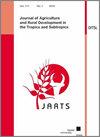Forage biomass availability, species diversity and seasonal variation in grazing behaviour of cattle in the outskirts of Ouagadougou
Q3 Social Sciences
Journal of Agriculture and Rural Development in the Tropics and Subtropics
Pub Date : 2020-10-16
DOI:10.17170/KOBRA-202007291510
引用次数: 1
Abstract
In order to determine the exploitation of grazing areas in the outskirts of Ouagadougou by cattle herds, the grazing behaviour of cows was monitored in five villages in these during three distinct seasons, namely wet, cool dry and hot dry season. A vegetation study including a census of the woody and herbaceous stratum of grazing areas allowed for an assessment of the pasture biomass availability during the wet season. Results of the monitoring of cattle herds showed that the land type grazed by cattle in the outskirts of the city varied depending on the season. While fallows and post-harvest fields constituted the main land type grazed by cattle in the wet and cool dry season, respectively, cattle herds exploited a variety of land types in the hot dry season. Consequently, cows travelled longer distances and spent more time on walking and browsing and less time on grazing in the hot dry season than in the cool dry and wet season. The pastoral value of grazing areas during the wet season, an important indicator for the quality of the grazing areas being based on the pastoral composition and the global quality index, was estimated at 61.1 %. The biomass was mainly dominated by annual grasses and legumes. The total annual above-ground biomass produced amounted to 575 kg DM ha -1 , equivalent to a qualified forage production of 324 kg DM ha -1 and a carrying capacity of 0.084 TLU ha -1 . In total, over 100 different herbaceous and 48 woody species were identified, each belonging to 20 families. Despite a high diversity of woody and herbaceous species, it is recommended to reduce the grazing pressure of cattle herds in the outskirts of Ouagadougou by addressing alternative feeding strategies.瓦加杜古郊区牧草生物量可用性、物种多样性和牛放牧行为的季节变化
为了确定牛群对瓦加杜古郊区牧区的利用情况,在三个不同的季节,即湿季、干冷季和干热季,监测了五个村庄奶牛的放牧行为。一项植被研究,包括对放牧地区的木本和草本层进行普查,以评估牧草在雨季的生物量可用性。畜群监测结果表明,城市郊区不同季节的牛放牧土地类型不同。在湿旱季和冷旱季,休耕和收获后田分别是牛放牧的主要土地类型,而在热旱季,牛利用了多种土地类型。因此,在炎热的旱季,奶牛比在凉爽的干湿季节走得更远,花更多的时间走路和吃草,花更少的时间吃草。雨季牧区的牧养价值是衡量牧区质量的重要指标,基于牧区组成和全球质量指数,估计为61.1%。生物量以一年生禾本科和豆科植物为主。每年生产的地上生物量总量为575 kg DM ha -1,相当于合格的饲料产量324 kg DM ha -1,承载能力为0.084 TLU ha -1。共鉴定出草本植物100余种,木本植物48种,分属20科。尽管木本和草本物种多样性很高,但建议通过解决替代喂养策略来减少瓦加杜古郊区牛群的放牧压力。
本文章由计算机程序翻译,如有差异,请以英文原文为准。
求助全文
约1分钟内获得全文
求助全文
来源期刊
CiteScore
2.30
自引率
0.00%
发文量
0
审稿时长
>36 weeks
期刊介绍:
The Journal of Agriculture and Rural Development in the Tropics and Subtropics publishes papers dealing with original research and review papers in the fields of plant production, animal nutrition and animal husbandry, soil science, rural economy and farm management, forestry and forest economy, veterinary hygiene and protection against epidemics.

 求助内容:
求助内容: 应助结果提醒方式:
应助结果提醒方式:


